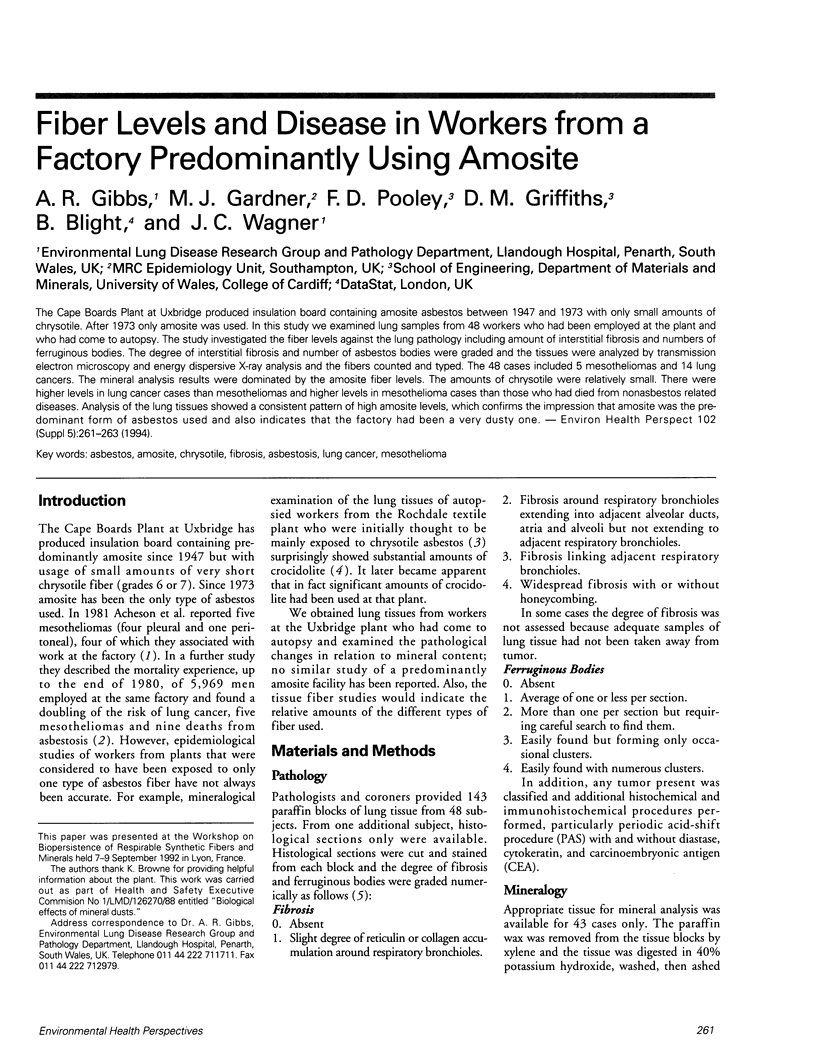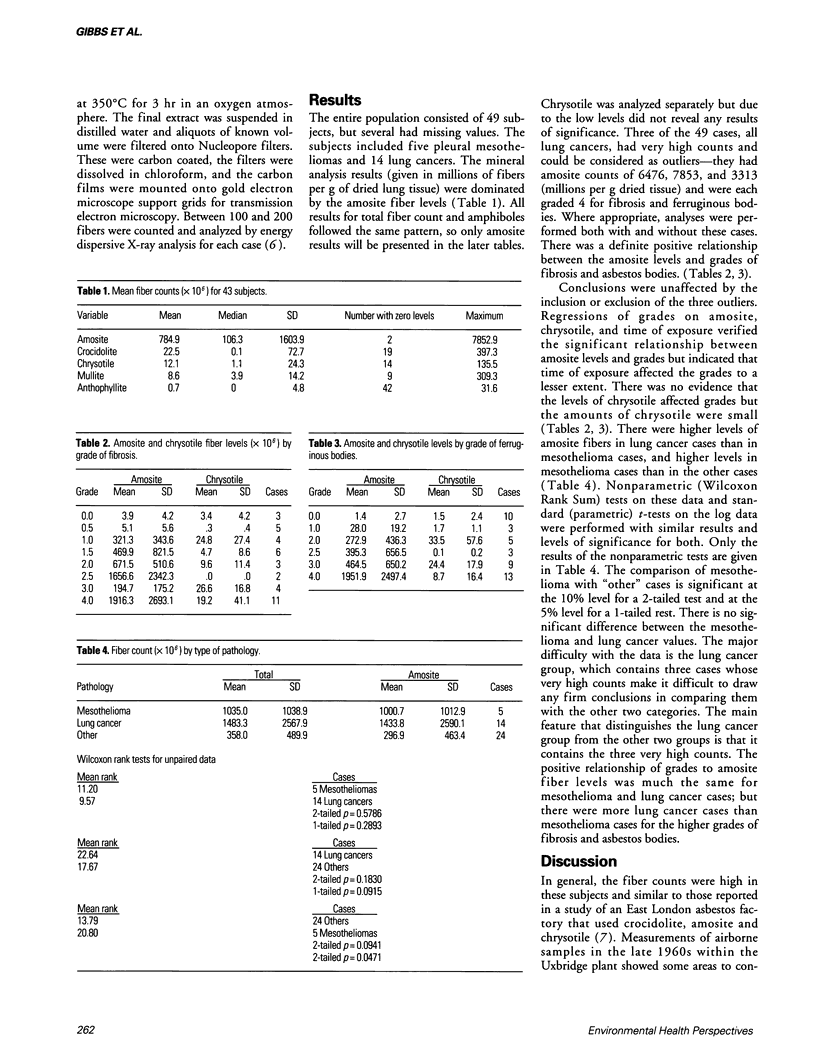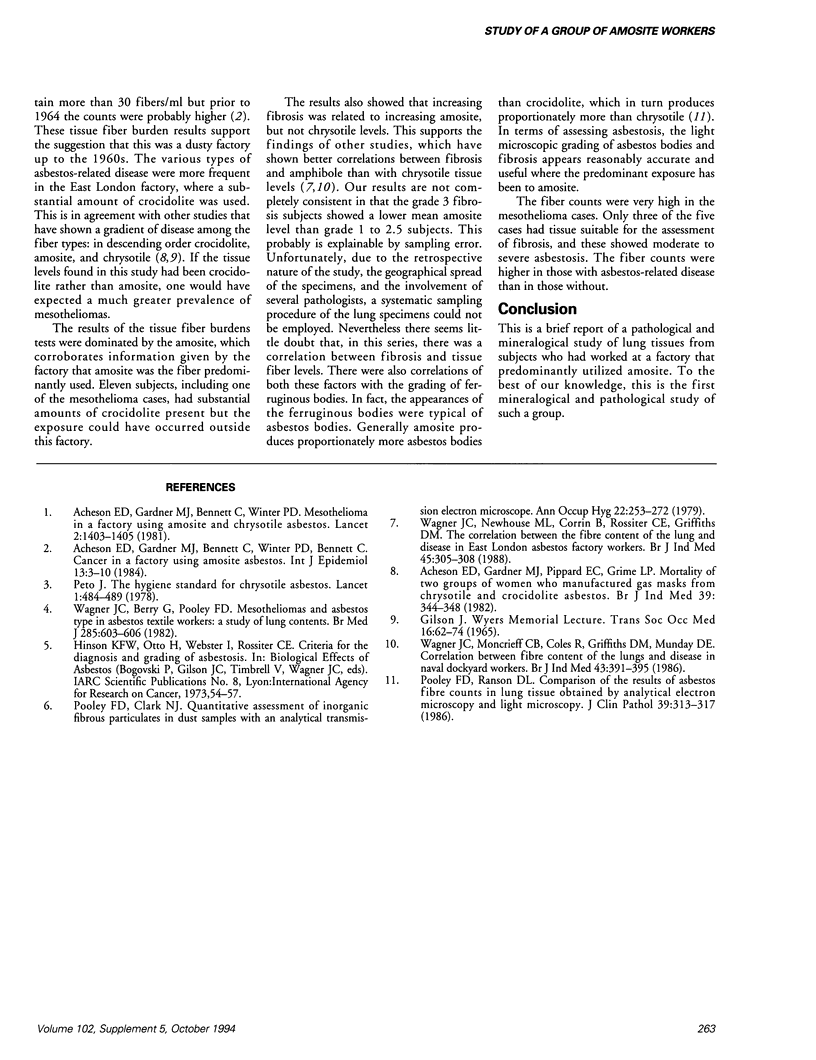Abstract
The Cape Boards Plant at Uxbridge produced insulation board containing amosite asbestos between 1947 and 1973 with only small amounts of chrysotile. After 1973 only amosite was used. In this study we examined lung samples from 48 workers who had been employed at the plant and who had come to autopsy. The study investigated the fiber levels against the lung pathology including amount of interstitial fibrosis and numbers of ferruginous bodies. The degree of interstitial fibrosis and number of asbestos bodies were graded and the tissues were analyzed by transmission electron microscopy and energy dispersive X-ray analysis and the fibers counted and typed. The 48 cases included 5 mesotheliomas and 14 lung cancers. The mineral analysis results were dominated by the amosite fiber levels. The amounts of chrysotile were relatively small. There were higher levels in lung cancer cases than mesotheliomas and higher levels in mesothelioma cases than those who had died from nonasbestos related diseases. Analysis of the lung tissues showed a consistent pattern of high amosite levels, which confirms the impression that amosite was the predominant form of asbestos used and also indicates that the factory had been a very dusty one.
Full text
PDF


Selected References
These references are in PubMed. This may not be the complete list of references from this article.
- Acheson E. D., Bennett C., Gardner M. J., Winter P. D. Mesothelioma in a factory using amosite and chrysotile asbestos. Lancet. 1981 Dec 19;2(8260-61):1403–1406. doi: 10.1016/s0140-6736(81)92813-0. [DOI] [PubMed] [Google Scholar]
- Acheson E. D., Gardner M. J., Pippard E. C., Grime L. P. Mortality of two groups of women who manufactured gas masks from chrysotile and crocidolite asbestos: a 40-year follow-up. Br J Ind Med. 1982 Nov;39(4):344–348. doi: 10.1136/oem.39.4.344. [DOI] [PMC free article] [PubMed] [Google Scholar]
- Acheson E. D., Gardner M. J., Winter P. D., Bennett C. Cancer in a factory using amosite asbestos. Int J Epidemiol. 1984 Mar;13(1):3–10. doi: 10.1093/ije/13.1.3. [DOI] [PubMed] [Google Scholar]
- Gilson J. C. Health hazards of asbestos. Recent studies on its biological effects. Trans Soc Occup Med. 1966 Jul;16(3):62–74. doi: 10.1093/occmed/16.3.62. [DOI] [PubMed] [Google Scholar]
- Peto J. The hygiene standard for chrysotile asbestos. Lancet. 1978 Mar 4;1(8062):484–489. doi: 10.1016/s0140-6736(78)90145-9. [DOI] [PubMed] [Google Scholar]
- Pooley F. D., Clark N. J. Quantitative assessment of inorganic fibrous particulates in dust samples with an analytical transmission electron microscope. Ann Occup Hyg. 1979;22(3):253–271. doi: 10.1093/annhyg/22.3.253. [DOI] [PubMed] [Google Scholar]
- Pooley F. D., Ranson D. L. Comparison of the results of asbestos fibre dust counts in lung tissue obtained by analytical electron microscopy and light microscopy. J Clin Pathol. 1986 Mar;39(3):313–317. doi: 10.1136/jcp.39.3.313. [DOI] [PMC free article] [PubMed] [Google Scholar]
- Wagner J. C., Berry G., Pooley F. D. Mesotheliomas and asbestos type in asbestos textile workers: a study of lung contents. 1982 Aug 28-Sep 4Br Med J (Clin Res Ed) 285(6342):603–606. doi: 10.1136/bmj.285.6342.603. [DOI] [PMC free article] [PubMed] [Google Scholar]
- Wagner J. C., Moncrieff C. B., Coles R., Griffiths D. M., Munday D. E. Correlation between fibre content of the lungs and disease in naval dockyard workers. Br J Ind Med. 1986 Jun;43(6):391–395. doi: 10.1136/oem.43.6.391. [DOI] [PMC free article] [PubMed] [Google Scholar]
- Wagner J. C., Newhouse M. L., Corrin B., Rossiter C. E., Griffiths D. M. Correlation between fibre content of the lung and disease in east London asbestos factory workers. Br J Ind Med. 1988 May;45(5):305–308. doi: 10.1136/oem.45.5.305. [DOI] [PMC free article] [PubMed] [Google Scholar]


